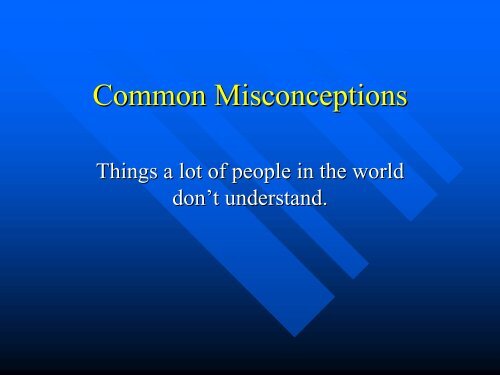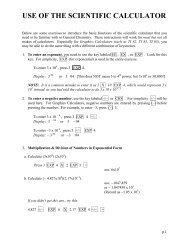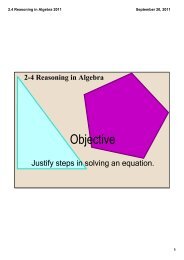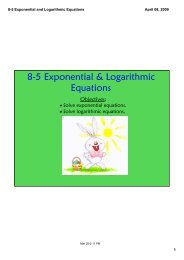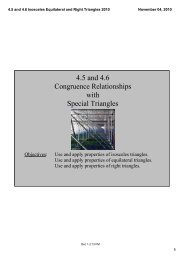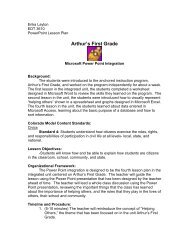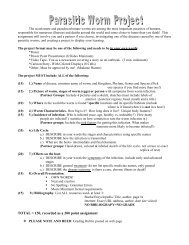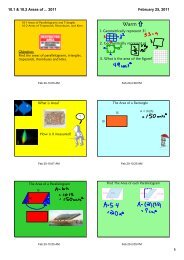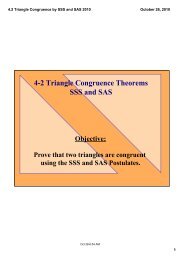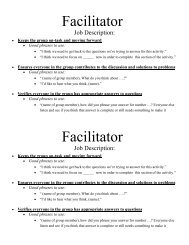Common Misconceptions PowerPoint
Common Misconceptions PowerPoint
Common Misconceptions PowerPoint
You also want an ePaper? Increase the reach of your titles
YUMPU automatically turns print PDFs into web optimized ePapers that Google loves.
<strong>Common</strong> <strong>Misconceptions</strong>Things a lot of people in the worlddon’t t understand.
<strong>Common</strong> <strong>Misconceptions</strong>• What is the shape of a raindrop?
<strong>Common</strong> <strong>Misconceptions</strong>• If you said ‘teardrop’ shaped, that isincorrect.• Rain drops are spherical, the simplestgeometric shape with lowest surface tovolume ratio. The same shape as stars,planets, and many living cells.• This is just one of many commonlymisunderstood ideas about the world aroundus.
<strong>Common</strong> <strong>Misconceptions</strong>• Are mass and weight the same thing?• No, they are not.• Mass is the amount of matter in an object orsample of matter.• Matter is anything that has mass and takesup space (has volume).• Mass is measured on a balance and hasunits of grams or kilograms.
Mass vs. Weight• So what is weight, and how is it differentfrom mass?• Weight is the force due to gravity on amass. It is measured using a spring scaleand can vary with location.• In the English system, weight is measuredin pounds.• Do you know the metric unit of weight?• It is the Newton (N).
Density• Many people also mistake weight fordensity.• Thus the old joke: ‘Which is heavier, apound of lead or a pound of feathers?’• They both WEIGH the same, but the lead isDENSER than the feathers.
Density• Density is how much matter is packed into agiven amount of space.• D = massvolume• Typically, mass will be in grams andvolume will be in cm 3 or mL. This is usedfor liquids and solids where the density isfairly high.
Density• For liquids, we usually use g/L.• Liters of volume are appropriate since thedensities of gases are quite low compared toliquids and solids.Solids areusually quitedense (g/cm 3 ).Liquids are usuallystill quite dense, butless than solids(g/cm 3 ).Gases are muchless dense (g/L).
Density• A good example of density involves water,mercury and air.• For water, 10mL has a mass of 10.0g.Water’s s density is 1.0g/mL (or 1.0g/cm 3 ).
Density• An equal volume of the liquid metalmercury would have a mass of 136g!• Mercury’s s density is 13.6g/cm 3 .
Density• 10 mL of air would only have a mass of0.013g. Air’s s density is 0.0013g/cm 3 or1.3g/L.How do you thinkthe density ofhelium comparesto that of normalair?
<strong>Common</strong> <strong>Misconceptions</strong>• Are temperature and heat the same thing?• Once again, like mass and weight, eventhough many people think of them as thesame, they are not.
Temperature vs. Heat• Ask yourself this question:• Given 2 objects, a steel BB and a steelhorseshoe, both at 500°, , which would domore damage or cause more pain if placedon your hand?• Of course, the horseshoe, but why?• The objects are both at the sametemperature.
Temperature vs. Heat• Temperature is a measure of the averagekinetic energy of the molecules in an object.• Kinetic energy is the energy of motion, sotemperature measures how fast themolecules are moving.• How is this different from heat?
Temperature vs. Heat• Heat is the total energy of all the moleculesin an object.• So heat depends on both the temperatureand the mass of an object.• That is why the more massive horseshoewould cause a worse burn than the BB.• Heat, like all other forms of energy ismeasured in joules (or calories).
A Question or Two• You have probablyseen footage of theastronauts in the spaceshuttle.• Are they weightless?• Where could you go tobe weightless?
Weightlessness• Law of UniversalGravitation.• There is reallynowhere you could goto be truly weightless.
<strong>Common</strong> Misconception• Speaking of laws, people oftenuse the terms law, hypothesis,and theory interchangeably.• Once again, they are not thesame thing.• A law, such as the ‘law ofgravity’is a statement or summaryof observed phenomena.• It does not explain why.
Law, Hypothesis and Theory• An hypothesis is a model or explanation forsomething that cannot be observed directly.• It is a guess about what will happen if anexperiment is conducted.• A good experiment is designedto disprove the hypothesis.
Hypothesis and Theory• So what is a theory?• If an hypothesis survives repeatedexperimentation, , it becomes a theory.• A theory is a model of a system that allowsus to make reliable predictions about whatwill happen in a new situation.• It may not be correct, but it is our best ideaabout how the system functions.
Atomic Theory• Probably the best known theory is theatomic theory.• It has been in existence for a long time, haschanged many times, and will continue tochange as new experiments are performed.• We will discuss atomic theory in moredetail in Unit 3.
Scientific Error• There are 2 categories of error.• Absolute error is the differencebetween the experimental valueand the accepted or true value(also called deviation.)• If an experiment were conductedand the value was off by 6million, what would you thinkabout the experiment?
Scientific Error• The absolute error doesn’t t mean muchwithout the relative error.• Relative error is the absolute error dividedby the accepted or true value. It puts theabsolute error into perspective.• If we were counting the atoms in a mole,the error of 6 million would be very, verysmall!
Scientific Error• Relative error is often expressed as apercent.• % Error = |Absolute deviation| x 100%Accepted value• We will do many examples of % error inour laboratory experiments this year.


